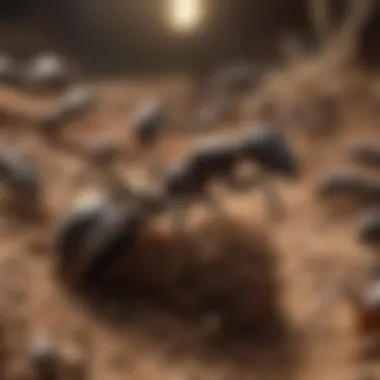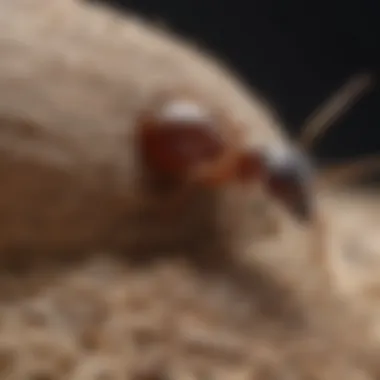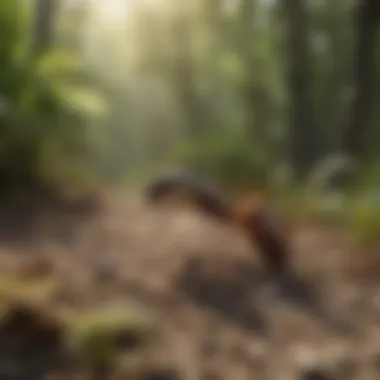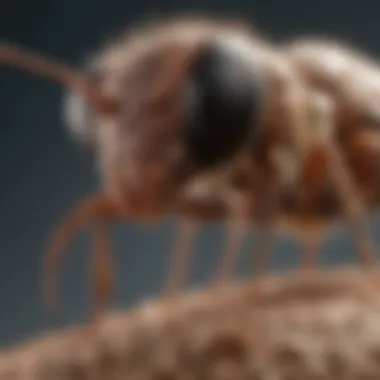Understanding Ant Activity After Treatment


Intro
In any discussion of pest control, understanding ant behavior is essential. Ants are social insects, often found in colonies, and they can be a nuisance in homes. When a treatment is applied to eliminate these pests, many homeowners wonder about the duration of ant activity post-treatment. How long will they remain visible? What factors influence their behavior after intervention? These questions are pivotal for devising effective pest management strategies.
Understanding the nuances of ant visibility after treatment is not just a matter of timing. It encompasses the effectiveness of the treatment used, the environmental conditions, and the ants' natural behaviors. Recognizing these factors can inform not only how one approaches pest control but also how long they can expect the effects of that control to last. This article aims to provide clarity on these elements, offering insights that can aid in effective pest management.
Prolusion to Ant Treatments
Ant treatments play a critical role in household pest management. Understanding how to effectively address ant infestations is essential for homeowners seeking a pest-free living environment. Ants can enter homes in search of food, water, or shelter, and their presence can lead to more significant problems if not managed properly. This section will explore key elements of various ant treatments, the expected outcomes, and considerations for optimal results.
Understanding Ant Behavior
Ant behavior is a vital aspect to consider when implementing treatment methods. Ants are social insects that live in colonies. Their activities involve foraging for food, building nests, and communicating with one another through pheromones. Understanding these behaviors can inform the choice of treatment.
Ants are generally active during specific times of the day, often in the early morning or later in the evening. Recognizing these patterns allows targeted treatment to be more effective. By treating the areas where ants are likely to travel or gather, homeowners can increase the likelihood of successful extermination. Behavioral insights also shed light on how quickly ants can rebuild their populations after treatment, emphasizing the importance of continual vigilance.
Importance of Timely Response
A timely response to ant infestations is crucial. If treatment is delayed, the colony can grow, and the effectiveness of any applied method may decrease. An early intervention also diminishes the overall risk of property damage and prevents ants from establishing long-lasting colonies inside the home.
The rapid reproductive capabilities of ants mean a small initial infestation can escalate quickly. Homeowners should monitor for signs of ant activity, such as trails or nests. Upon detection, immediate action should be taken to evaluate treatment options. Ignoring the signs can lead to prolonged infestations, making eradication more challenging and costly in the long run.
"Taking quick action is the key to effective pest management. The sooner the treatment, the better the outcome."
Types of Ant Treatments
Understanding the various types of ant treatments is crucial for effective pest control. This awareness not only aids homeowners in selecting the appropriate method but also ensures a targeted approach, ultimately improving treatment outcomes. The effectiveness of each treatment type can differ based on several factors such as species, environmental conditions, and the extent of the infestation. Therefore, being informed about the different treatments can help in minimizing confusion and preventing further ant activity.
Chemical Treatments
Chemical treatments are among the most widely used methods for ant control, offering quick results. These treatments primarily involve the use of insecticides, which can come in various formulations such as sprays, baits, and granules. Sprays are effective for immediate contact kills, while baits attract ants who then carry the poison back to their colonies, killing a larger number of ants over time.
When considering this method, it is important to choose the right product. Some chemicals are designed specifically for certain ant species, making their effectiveness more targeted. Read labels carefully and follow application instructions to ensure safety and efficacy. Possible concerns include harm to non-target species and environmental effects, which may prompt some homeowners to seek more sustainable options.
Natural Treatments
Natural treatments, or eco-friendly approaches, have gained popularity as alternatives to chemical-based solutions. These methods often utilize ingredients like diatomaceous earth, essential oils, or vinegar. Such options are less harmful to pets and children, which is a significant advantage for many households.
While natural treatments can be effective, their speed of action and overall reliability often varies. For instance, diatomaceous earth works by dehydrating ants but may take longer to see significant reductions in ant populations. Homeowners should be prepared to combine several natural methods for the best results and to be patient while waiting for the desired outcomes.
Professional Extermination Services
When ant infestations become overwhelming, professional extermination services can be a valuable resource. These services typically employ a combination of chemical and natural methods tailored specifically to each home and its needs. Exterminators possess specialized knowledge about local ant species, which allows them to devise targeted strategy that is often more effective than DIY solutions.
Working with professionals comes with a number of benefits. They can perform thorough inspections and assess the extent of the infestation, recommend appropriate treatments, and provide follow-up services to monitor the situation. However, hiring a professional can be costly, so homeowners must weigh the urgency of their situation against their budget.


In summary, each type of ant treatment has its unique pros and cons. Homeowners must assess their specific needs and situation before making decisions. By understanding the various treatment options, one can take informed steps towards effective ant management.
Factors Affecting Ant Visibility Post-Treatment
Understanding the factors affecting ant visibility after treatment is crucial for homeowners and those managing pest control. Ants are not just nuisances; they can influence the structural integrity of a property and the well-being of inhabitants. Once treatment is applied, discerning when the species might reappear informs future management strategies. The following sections delve into specific components that dictate ant visibility, such as the life cycle of ant colonies, species-specific behaviors, and environmental influences. Knowing these factors can lead to better pest management and long-term solutions.
Life Cycle of Ant Colonies
Ant colonies undergo distinct life cycle stages: egg, larva, pupa, and adult. The duration spent in each phase varies depending on the ant species and environmental conditions. After treatment, some stages may take longer to eliminate than others. For instance, ants in the eggs or pupal stages may remain hidden, even as adult ants are visible. This means that treatment might seem effective in the short term yet not kill all the life stages. To effectively manage ant infestations, it is necessary to recognize how treatments interact with these phases.
Key points about the life cycle include:
- Egg hatching: Ant eggs can take days to weeks to hatch. Treatment might not impact eggs immediately.
- Development time: Larvae and pupae typically require more time to develop, giving the colony a chance to regroup.
- Adult emergence: New adults can return to foraging shortly after treatment, leading to perceived infestation revival.
Understanding these stages provides insight into when to expect reduced visibility of ants and reapply treatments accordingly.
Species-Specific Differences
Different ant species exhibit varied responses to treatment. Some species are more resilient or adaptive, influencing how quickly they become visible again. For example, the Argentine ant may quickly recover following treatments that are effective against other species, such as carpenter ants. Species-specific differences can impact the efficacy of particular methods or treatments.
Considerations for species include:
- Behavioral adaptations: Certain species can learn and adapt to evade detection and treatment strategies.
- Nest location: Some species build nests in places that are hard to access, thus prolonging visibility post-treatment.
- Colony size: Larger colonies may take longer to exhibit declines in ant activity after treatment.
This variability means homeowners must adapt their strategies per the species involved to achieve effective pest management.
Environmental Influences
The environment where the treatment takes place plays a significant role in how long ants remain visible. Factors such as temperature, humidity, and food availability directly influence ant activity and behavior. For instance, warmer temperatures typically boost ant activity, while cooler temperatures can reduce it significantly.
Environmental aspects include:
- Seasonal changes: Ant activity often fluctuates with seasons, thereby affecting visibility after treatment.
- Moisture levels: High humidity can enhance food resource availability, prolonging ant activity post-treatment.
- Nearby food sources: If ample food remains, ants might be attracted back, undermining the effects of treatments.
Carefully consider these influences. All of these environmental factors interplay with the effectiveness of your pest management strategy and can make a significant difference in outcomes.
Understanding these three factors—life cycle, species differences, and environmental influences—equips you better to anticipate ant visibility after treatment. This knowledge is essential for effective long-term pest management solutions.
Expected Duration of Ant Visibility Post-Treatment
Understanding the expected duration of ant visibility post-treatment is essential for homeowners and property managers. This knowledge helps in evaluating the effectiveness of chosen pest control methods and setting proper expectations for the management of ant populations. This section discusses immediate reactions, short-term outcomes, and long-term perspectives following treatment. Readers can gain insights into how ant behavior operates after interventions and the implications of these observations.
Immediate Reactions
Immediately after treatment, the behaviour of ants can show noticeable changes. Depending on the method used, ants may exhibit disorientation. Some may become lethargic, while others may evacuate their nests. This reaction often depends on the treatment's nature. For instance, chemical sprays may lead to a quick decline in active ants visible in the area. Homeowners may notice a drop in ant traffic almost right away. However, this does not mean the problem is solved. The visibility can become misleading. It's important to monitor the area over the next few days for any signs of lingering activity.


Short-Term Outcomes
In the short term, which can extend from a few days to a couple of weeks after treatment, the visibility of ants can vary. Many ant species require time to respond fully to treatment. Meanwhile, queen ants, whose elimination is crucial in controlling colonies, often remain hidden during this period. As such, returning activity can be observed. This can happen quickly if treatment did not address the core of the infestation. It is crucial for homeowners to stay vigilant.
Common short-term signs include:
- A reduction in visible ant trails.
- Occasional sightings of ants in new locations.
- Signs of continued tunnelling or nest activity in hidden spaces.
Long-Term Perspectives
Long-term visibility can span from several weeks to months, depending on multiple factors, including species resilience and environmental conditions. Some ants are more adaptive to control measures than others. Understanding how long ants remain visible after treatment offers insight into potential re-infestation risks.
Using a natural or professional intervention often determines long-term outcomes as well. Environmental influences, such as food availability and shelter, play an essential role. Moreover, ants communicate with one another, informing their colonies of potential threats. This means that if an ant survives treatment, it can signal others to return or remain hidden until it is safe.
"Understanding the timelines of ant visibility is pivotal for effective pest management. Immediate reactions may be deceiving, making follow-up critical."
Homeowners should consider revisiting the treated area periodically for inspections. If visibility returns, it may indicate that further actions are necessary to uphold a pest-free environment.
What to Observe After Treatment
Understanding what to observe after treatment is crucial for assessing the effectiveness of ant control methods. In this stage, careful observation can provide insights into whether the treatment was successful or if further action is necessary. Key elements to look for encompass signs of effective treatment versus any indicators of continued ant activity. This knowledge empowers homeowners and housewives alike to make informed decisions about subsequent measures.
Signs of Effective Treatment
Identifying signs that indicate a positive response to treatment plays a vital role in pest management. Effective treatment entails various observable outcomes that suggest ants are no longer active. Here are several indicators:
- Decreased Ant Activity: A notable drop in the number of ants observed either inside or around the home is a strong indicator. Over a few days post-treatment, there should be a significant reduction in visible activity.
- Absence of Ant Trails: Ants often follow specific pathways, known as trails. A lack of these trails can suggest that the treatment has disrupted their behavior.
- Dead Ants: The presence of dead ants near treatment areas confirms that the treatment has had a lethal effect.
- Fewer Recruits at Food Sources: When ants find food, they create a trail to signal to their colony. If fewer ants appear at known food sources, this also indicates effective treatment.
- Behavior Change: Watch for unusual ant behavior. Ants that are part of a dying colony might exhibit confusion or erratic movements. This can show that the treatment is impairing their normal functioning.
"Understanding observed behaviors post-treatment provides a clearer picture of treatment effectiveness and the next best steps to control any infestations."
Indicators of Continued Activity
Despite effective treatments, some signs may show that ants are still active or are returning. Recognizing these indicators promptly can assist in determining the need for further action. Key signs of continued activity include:
- Reinforced Ant Trails: If trails reappear after treatment, this may point to a persistent problem that requires more focused attention.
- Resurgence of Visible Ants: After a temporary decline in ant sightings, a sudden increase suggests that the initial treatment did not eliminate the source of the infestation.
- New Nesting Sites: Observation of ants creating new nests indicates re-colonization. They may be locating new environments that offer better shelter and resources.
- Altered Foraging Patterns: If ants change their foraging habits, such as appearing at different times or locations, they may be adapting to avoid treatment effects.
- Scattered Debris: Continued signs of ant activity may also include debris like food wrappers or nesting materials. This can imply that ants still have access to resources.
When to Seek Professional Help
Assessment of ant activity post-treatment requires careful observation. Some situations may push homeowners to consider professional help for pest management. While various treatments are available for ant control, not all are equally successful.
Unsuccessful Treatments
Determining when a treatment fails is critical. If there are no significant changes in ant visibility within a few weeks after application, this is a warning sign. Unsuccessful treatments often mean that the methods used were ineffective against the specific type of ant or that the colony has adapted.
Signs that a treatment has failed include:


- Consistent ant sightings: Noticing ants in the same areas of the home repeatedly.
- Increased activity: Seeing more ants after treatment can indicate that the infestation persists.
- No change in behavior: If the ants continue their daily activities without disruption, this suggests resistance to the treatment.
In these cases, consulting professionals is wise. Exterminators can provide advanced solutions based on experiences with specific ant species. A repeated treatment without expert insight may lead to wasted resources and ongoing frustrations.
Persistent Infestations
An ongoing infestation signifies that it's time to get help. A persistent presence of ants indicates that DIY methods may not resolve the issue. Factors leading to persistent infestations may include:
- Hidden colonies: Ants often nest in places that are hard to access or detect.
- Species characteristics: Certain species, like carpenter ants, require different approaches than more common types.
- Environmental factors: Changes in the environment can cause ants to relocate their colonies close to your home.
If you notice ants returning despite treatment efforts, don't hesitate to reach out to pest control services. Specialists possess the knowledge and equipment to address complex infestations. Their services often include inspection and tailored treatments that are more effective than retail options.
"Timely action with the help of professionals can save costs and prevent long-term damage to the home."
Preventing Future Infestations
Preventing future infestations is a critical aspect of effective pest management. After dealing with an ant problem, it is essential to implement strategies that not only address the current situation but also reduce the chances of re-infestation. Understanding the underlying causes that can lead to an invasion is key to developing a robust prevention plan. This aspect significantly influences the long-term success of pest control efforts and promotes a healthier living environment.
Regular Maintenance Strategies
Regular maintenance is a proactive approach to pest control. It involves continuous inspection and upkeep of the home and surroundings to detect issues before they escalate. This can be accomplished through simple yet effective practices such as:
- Routine Cleaning: Keeping kitchens and dining areas clean reduces food sources for ants. Promptly wipe up spills and crumbs, and store food in sealed containers.
- Sealing Entry Points: Inspect your home for cracks and crevices that could serve as entry points for ants. Use caulk or sealants to fill these gaps, especially around windows, doors, and foundation.
- Trimming Vegetation: Keep shrubs and trees trimmed back from the home. Plants that touch the house provide ants with a pathway indoors.
- Proper Waste Management: Dispose of garbage regularly and use trash cans with tight-fitting lids. Ants are attracted to food waste, so maintaining cleanliness in disposal areas is crucial.
Implementing these strategies can significantly decrease the likelihood of ant problems in the future. Additionally, fostering a habit of regular inspections and maintenance can lead to the early identification of any signs of pest activity.
Environmental Modifications
Making environmental modifications is another effective way to prevent ant infestations. This concept revolves around altering the surroundings to make them less conducive to ant activity. Key modifications include:
- Water Management: Ants require water for survival. Fix leaky pipes and eliminate standing water in yards or around the house to deter ants from gathering.
- Creating Barriers: Consider installing landscape fabric or gravel around flower beds to reduce ant access to the home. This can also inhibit their nesting abilities in the soil.
- Landscaping Choices: Opt for plants that are less attractive to ants. Some species have natural repellant qualities. Using mulch strategically can also make environments less favorable for ant nests.
Adopting these environmental changes fosters a less inviting habitat for ants. It not only suppresses current populations but may also prevent potential new colonies from establishing themselves. Overall, both regular maintenance and environmental modifications can function synergistically to enhance your home's defenses against future ant infestations.
Ending
Understanding the duration and implications of ant activity post-treatment is vital for effective pest control and management. This article emphasizes several key elements that help you gain insight into what to expect after treatments. Recognizing that different ant species behave uniquely allows homeowners to tailor their strategies for maximum effectiveness.
Recap of Key Points
- Ant Treatment Effectiveness: Treatments can vary in effectiveness depending on the chosen method. Chemical treatments often provide immediate results, while natural options may require patience.
- Visible Ant Activity Duration: Ant visibility changes after treatment. Immediate reactions can be observed, with initial declines often followed by sporadic returns, especially if the colony remains intact.
- Factors Influencing Reappearance: Understanding the life cycle of ants and environmental conditions can explain why some ants continue to appear post-treatment. Species-specific behavior also plays a role in this reoccurrence.
- Signs of Success: Effective treatments lead to diminished signs of ant activity. Conversely, persistent activity may indicate the need for reevaluation of treatment methods.
Future Considerations in Ant Management
In considering future ant management strategies, several factors merit attention:
- Preventive Measures: Regular maintenance and environmental modifications can significantly reduce the likelihood of future infestations. Keeping food sealed and maintaining cleanliness are fundamental.
- Ongoing Education: Homeowners should stay informed about ant behavior and treatment advancements. Researching insights, such as those from reliable sources like Wikipedia and Britannica, can enrich your knowledge.
- Professional Consultation: When encountering significant infestations, seeking professional help may be required. Expert guidance can provide tailored solutions based on specific home environments.
- Monitoring Changes: Post-treatment, homeowners should actively monitor changes in ant activity. Keeping a diary of sightings can help understand patterns and efficacy of treatment methods.
"Knowledge about ant visibility and behavior after treatments is crucial for effective pest management."
The article collects what you need to understand about ants after trying to control them. Realizing the implications of your ant management choices can empower you, helping reduce frustration and increase success in dealing with these pests.



